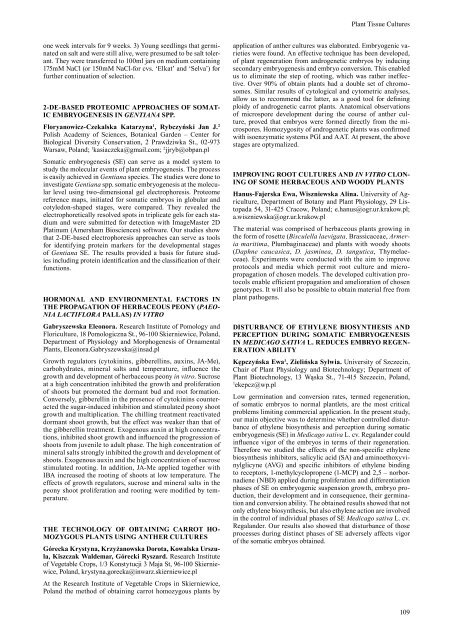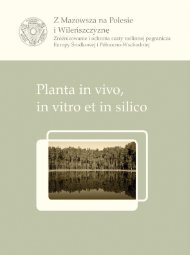acta societatis botanicorum poloniae - LV Zjazd Polskiego ...
acta societatis botanicorum poloniae - LV Zjazd Polskiego ...
acta societatis botanicorum poloniae - LV Zjazd Polskiego ...
Create successful ePaper yourself
Turn your PDF publications into a flip-book with our unique Google optimized e-Paper software.
one week intervals for 9 weeks. 3) Young seedlings that germinated<br />
on salt and were still alive, were presumed to be salt tolerant.<br />
They were transferred to 100ml jars on medium containing<br />
175mM NaCl (or 150mM NaCl-for cvs. ‘Elkat’ and ‘Selva’) for<br />
further continuation of selection.<br />
2-dE-BASEd PrOTEOMIC APPrOACHES OF SOMAT-<br />
IC EMBrYOGENESIS IN GentiAnA SPP.<br />
Floryanowicz-Czekalska Katarzyna 1 , Rybczyński Jan J. 2<br />
Polish Academy of Sciences, Botanical Garden – Center for<br />
Biological Diversity Conservation, 2 Prawdziwka St., 02-973<br />
Warsaw, Poland; 1 kasiaczeka@gmail.com; 2 jjryb@obpan.pl<br />
Somatic embryogenesis (SE) can serve as a model system to<br />
study the molecular events of plant embryogenesis. The process<br />
is easily achieved in Gentiana species. The studies were done to<br />
investigate Gentiana spp. somatic embryogenesis at the molecular<br />
level using two-dimensional gel electrophoresis. Proteome<br />
reference maps, initiated for somatic embryos in globular and<br />
cotyledon-shaped stages, were compared. They revealed the<br />
electrophoretically resolved spots in triplicate gels for each stadium<br />
and were submitted for detection with ImageMaster 2D<br />
Platinum (Amersham Biosciences) software. Our studies show<br />
that 2-DE-based electrophoresis approaches can serve as tools<br />
for identifying protein markers for the developmental stages<br />
of Gentiana SE. The results provided a basis for future studies<br />
including protein identification and the classification of their<br />
functions.<br />
HOrMONAL ANd ENVIrONMENTAL FACTOrS IN<br />
THE PrOPAGATION OF HErBACEOUS PEONY (PAeoniA<br />
lActiflorA PALLAS) in vitro<br />
Gabryszewska Eleonora. Research Institute of Pomology and<br />
Floriculture, 18 Pomologiczna St., 96-100 Skierniewice, Poland,<br />
Department of Physiology and Morphogenesis of Ornamental<br />
Plants, Eleonora.Gabryszewska@insad.pl<br />
Growth regulators (cytokinins, gibberellins, auxins, JA-Me),<br />
carbohydrates, mineral salts and temperature, influence the<br />
growth and development of herbaceous peony in vitro. Sucrose<br />
at a high concentration inhibited the growth and proliferation<br />
of shoots but promoted the dormant bud and root formation.<br />
Conversely, gibberellin in the presence of cytokinins counteracted<br />
the sugar-induced inhibition and stimulated peony shoot<br />
growth and multiplication. The chilling treatment reactivated<br />
dormant shoot growth, but the effect was weaker than that of<br />
the gibberellin treatment. Exogenous auxin at high concentrations,<br />
inhibited shoot growth and influenced the progression of<br />
shoots from juvenile to adult phase. The high concentration of<br />
mineral salts strongly inhibited the growth and development of<br />
shoots. Exogenous auxin and the high concentration of sucrose<br />
stimulated rooting. In addition, JA-Me applied together with<br />
IBA increased the rooting of shoots at low temperature. The<br />
effects of growth regulators, sucrose and mineral salts in the<br />
peony shoot proliferation and rooting were modified by temperature.<br />
THE TECHNOLOGY OF OBTAINING CArrOT HO-<br />
MOZYGOUS PLANTS USING ANTHEr CULTUrES<br />
Górecka Krystyna, Krzyżanowska Dorota, Kowalska Urszula,<br />
Kiszczak Waldemar, Górecki ryszard. Research Institute<br />
of Vegetable Crops, 1/3 Konstytucji 3 Maja St, 96-100 Skierniewice,<br />
Poland, krystyna.gorecka@inwarz.skierniewice.pl<br />
At the Research Institute of Vegetable Crops in Skierniewice,<br />
Poland the method of obtaining carrot homozygous plants by<br />
Plant Tissue Cultures<br />
application of anther cultures was elaborated. Embryogenic varieties<br />
were found. An effective technique has been developed,<br />
of plant regeneration from androgenetic embryos by inducing<br />
secondary embryogenesis and embryo conversion. This enabled<br />
us to eliminate the step of rooting, which was rather ineffective.<br />
Over 90% of obtain plants had a double set of chromosomes.<br />
Similar results of cytological and cytometric analyses,<br />
allow us to recommend the latter, as a good tool for defining<br />
ploidy of androgenetic carrot plants. Anatomical observations<br />
of microspore development during the course of anther culture,<br />
proved that embryos were formed directly from the microspores.<br />
Homozygosity of androgenetic plants was confirmed<br />
with isoenzymatic systems PGI and AAT. At present, the above<br />
stages are optymalized.<br />
IMPrOVING rOOT CULTUrES ANd in vitro CLON-<br />
ING OF SOME HErBACEOUS ANd WOOdY PLANTS<br />
Hanus-Fajerska Ewa, Wiszniewska Alina. University of Agriculture,<br />
Department of Botany and Plant Physiology, 29 Listopada<br />
54, 31-425 Cracow, Poland; e.hanus@ogr.ur.krakow.pl;<br />
a.wiszniewska@ogr.ur.krakow.pl<br />
The material was comprised of herbaceous plants growing in<br />
the form of rosette (Bisculella laevigata, Brassicaceae, Armeria<br />
maritima, Plumbaginaceae) and plants with woody shoots<br />
(Daphne caucasica, D. jasminea, D. tangutica, Thymelaeceae).<br />
Experiments were conducted with the aim to improve<br />
protocols and media which permit root culture and micropropagation<br />
of chosen models. The developed cultivation protocols<br />
enable efficient propagation and amelioration of chosen<br />
genotypes. It will also be possible to obtain material free from<br />
plant pathogens.<br />
dISTUrBANCE OF ETHYLENE BIOSYNTHESIS ANd<br />
PErCEPTION dUrING SOMATIC EMBrYOGENESIS<br />
IN medicAGo sAtivA L. rEdUCES EMBrYO rEGEN-<br />
ErATION ABILITY<br />
Kępczyńska Ewa 1 , Zielińska Sylwia. University of Szczecin,<br />
Chair of Plant Physiology and Biotechnology; Department of<br />
Plant Biotechnology, 13 Wąska St., 71-415 Szczecin, Poland,<br />
1 ekepcz@wp.pl<br />
Low germination and conversion rates, termed regeneration,<br />
of somatic embryos to normal plantlets, are the most critical<br />
problems limiting commercial application. In the present study,<br />
our main objective was to determine whether controlled disturbance<br />
of ethylene biosynthesis and perception during somatic<br />
embryogenesis (SE) in Medicago sativa L. cv. Regalander could<br />
influence vigor of the embryos in terms of their regeneration.<br />
Therefore we studied the effects of the non-specific ethylene<br />
biosynthesis inhibitors, salicylic acid (SA) and aminoethoxyvinylglicyne<br />
(AVG) and specific inhibitors of ethylene binding<br />
to receptors, 1-methylcyclopropene (1-MCP) and 2,5 – norbornadiene<br />
(NBD) applied during proliferation and differentiation<br />
phases of SE on embryogenic suspension growth, embryo production,<br />
their development and in consequence, their germination<br />
and conversion ability. The obtained results showed that not<br />
only ethylene biosynthesis, but also ethylene action are involved<br />
in the control of individual phases of SE Medicago sativa L. cv.<br />
Regalander. Our results also showed that disturbance of those<br />
processes during distinct phases of SE adversely affects vigor<br />
of the somatic embryos obtained.<br />
109



